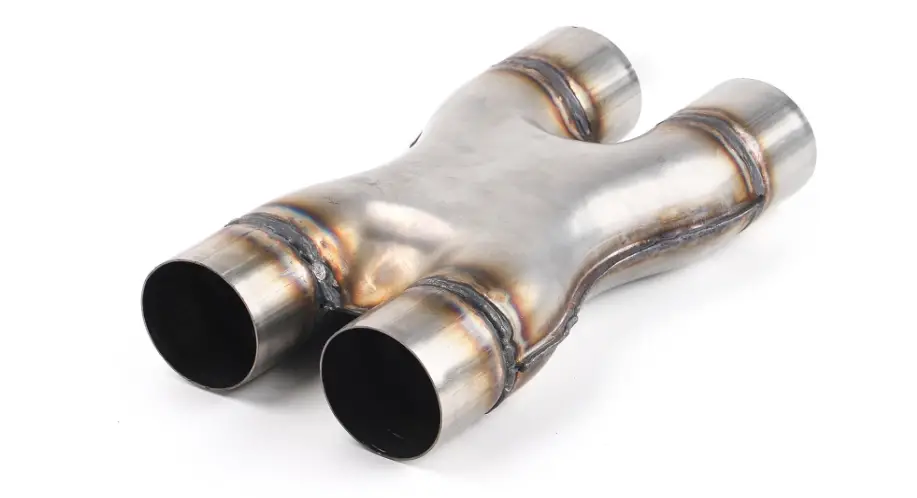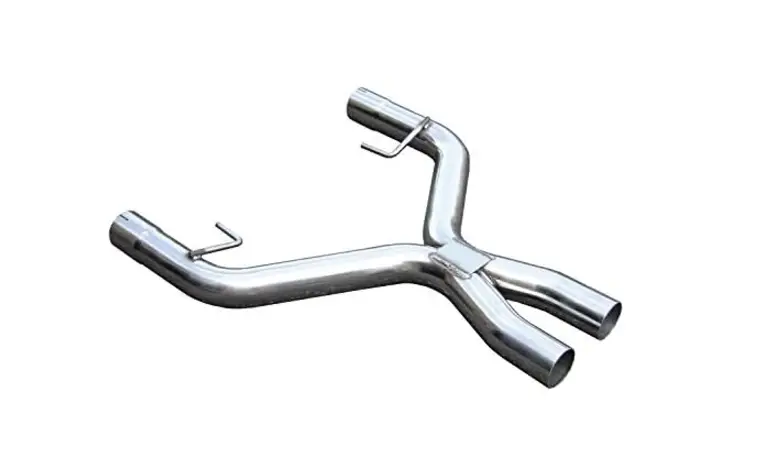An X-pipe improves exhaust flow by merging gases from both cylinder banks, reducing backpressure, and enhancing performance. It boosts horsepower and creates a smoother, higher-pitched exhaust sound.
When it comes to upgrading your vehicle’s exhaust system, an X-pipe is a popular choice among car enthusiasts and performance seekers. Designed as a crossover pipe that connects the two sides of a dual exhaust system, the X-pipe plays a important role in optimizing exhaust flow. But what exactly does it do, and how does it impact your vehicle’s performance and sound?
In this article, we’ll dive into the function of an X-pipe, how it differs from other configurations like H-pipes, and why it’s a favorite for those looking to enhance their car’s exhaust note and overall efficiency.

Contents
Exhaust Systems
The exhaust system primarily serves three functions:
- Expelling Exhaust Gases: The system routes harmful gases from the engine away from the cabin to ensure safety.
- Improving Engine Performance: By optimizing the flow of gases, the system can enhance engine power and efficiency.
- Tuning the Sound: The configuration of the exhaust system determines the vehicle’s sound profile.
In most V6, V8, or other multi-cylinder engines, exhaust gases exit through two separate banks of cylinders. This setup creates the need for a crossover pipe to balance and optimize exhaust flow. Enter the X-pipe.
What Is an X-Pipe?
An X-pipe is a crossover component typically found in dual-exhaust systems. Shaped like the letter “X,” it merges the exhaust flow from both cylinder banks at a central junction. Unlike other crossover designs, such as the H-pipe, the X-pipe creates a smoother, more continuous flow of gases.
The X-pipe’s design is rooted in aerodynamics. As exhaust gases merge at the crossover point, their paths are streamlined, reducing turbulence and increasing efficiency. This design plays a crucial role in enhancing performance and sound.
What Does An X Pipe Do For Exhaust?
To understand the functionality of an X-pipe, let’s break it down:
- Equalizing Pressure: In a dual-exhaust system, each cylinder bank produces exhaust gases independently. This creates uneven pressure levels between the two sides. The X-pipe balances these pressures by merging the gases, which allows for a more uniform flow.
- Enhancing Scavenging: Scavenging refers to the process of removing spent exhaust gases from the combustion chamber to make room for fresh air-fuel mixtures. The X-pipe improves scavenging by creating a vacuum effect, drawing gases out more efficiently.
- Reducing Backpressure: Turbulence and pressure build-up in the exhaust system can impede gas flow. The X-pipe’s streamlined design reduces backpressure, which can improve horsepower and torque.
- Sound Tuning: The X-pipe also impacts the sound of the exhaust. By merging the two exhaust flows, it creates a higher-pitched, smoother tone, often compared to a European sports car.
Benefits of Installing an X Pipe
Installing an X-pipe can bring several benefits, particularly for performance-oriented vehicles. Here’s a detailed look at the advantages:
- Performance Gains:
- By reducing backpressure and enhancing scavenging, an X-pipe can contribute to noticeable performance improvements, particularly at higher RPMs.
- This translates to increased horsepower and torque, especially in vehicles with powerful engines.
- Improved Exhaust Flow:
- The X-pipe promotes a more efficient exhaust flow, which can lead to better engine breathing and overall efficiency.
- Sound Enhancement:
- If you prefer a crisp, refined exhaust note, an X-pipe is an excellent choice. It smoothens the raspy tones often associated with high-performance engines and eliminates some low-frequency drone.
- Fuel Efficiency:
- While not its primary purpose, the improved exhaust efficiency can contribute to marginal gains in fuel economy by optimizing combustion.
- Reduced Emissions:
- A well-designed X-pipe can help reduce emissions by promoting more complete combustion of exhaust gases.

X Pipe vs H Pipe: What’s the Difference?
When choosing a crossover pipe, the primary alternatives are the X-pipe and the H-pipe. Each has its advantages, depending on your goals.
| Feature | X-Pipe | H-Pipe |
|---|---|---|
| Design | Smooth “X” junction | Simple “H” junction |
| Sound Profile | Higher-pitched, refined tone | Deeper, classic rumble |
| Performance Focus | High-RPM power gains | Low- and mid-range torque |
| Flow Dynamics | Streamlined, low turbulence | Moderate turbulence |
While the X-pipe excels in performance and sound refinement, the H-pipe is favored by enthusiasts who prefer a traditional muscle car growl and prioritize low-end torque.
When Should Install an X-Pipe?
An X-pipe is most beneficial in the following scenarios:
- High-Performance Applications: Vehicles with high-revving engines, such as sports cars, benefit significantly from the X-pipe’s ability to enhance top-end power.
- Dual-Exhaust Systems: If your vehicle features a dual-exhaust setup, an X-pipe is an easy upgrade for better flow and sound.
- Customization Projects: Enthusiasts seeking a distinct exhaust note often turn to X-pipes for their sound-tuning capabilities.
- Track and Street Use: The performance gains from an X-pipe are ideal for track-focused cars but are equally appreciated on street vehicles.
Potential Drawbacks of an X-Pipe
While the X-pipe has numerous advantages, it’s not without limitations:
- Compatibility: Not all vehicles are designed for an X-pipe upgrade, particularly those with single-exhaust systems.
- Cost: X-pipes can be more expensive than other crossover options due to their design and performance benefits.
- Complex Installation: Proper installation requires precise alignment and welding, often necessitating professional assistance.
- Sound Preference: If you prefer a deeper, old-school exhaust note, the X-pipe’s refined sound may not suit your taste.
Installation Considerations
If you decide to install an X-pipe, here are a few things to keep in mind:
- Material: Choose high-quality materials such as stainless steel for durability and resistance to corrosion.
- Placement: The X-pipe should be installed closer to the engine for optimal scavenging and performance gains.
- Professional Installation: While some experienced DIYers can handle the installation, seeking professional help ensures precision and longevity.
Related Article
Exhaust Pipe Paint
How to Bend Exhaust Pipe
Water in Exhaust Pipe
Frequently Asked Questions
Here are some FAQs about X pipes –
1. How does an X-pipe improve horsepower?
An X-pipe reduces backpressure and improves scavenging, allowing the engine to expel exhaust gases more efficiently. This optimizes the engine’s ability to intake fresh air-fuel mixtures, leading to increased horsepower, especially at higher RPMs.
2. Will an X-pipe make my car louder?
Not necessarily louder, but it will change the tone of your exhaust. An X-pipe creates a smoother, higher-pitched sound compared to the deeper rumble of an H-pipe.
3. Can I install an X-pipe on any car?
X-pipes are typically designed for dual-exhaust systems. Vehicles with single-exhaust setups or limited space may not accommodate an X-pipe without significant modifications.
4. Do X-pipes affect emissions?
Yes, by promoting more efficient combustion and exhaust flow, an X-pipe can help reduce emissions. However, ensure it complies with local emission regulations.
5. How much does it cost to install an X-pipe?
The cost varies based on the vehicle, material, and labor. An X-pipe itself can range from $150 to $500, with professional installation adding $200 to $500.
Conclusion
An X-pipe is a valuable addition to any high-performance exhaust system, offering improvements in power, efficiency, and sound. Whether you’re seeking a refined exhaust note or incremental horsepower gains, an X-pipe delivers a compelling blend of form and function. Before proceeding, consider the vehicle’s compatibility, sound preferences, and performance goals to determine if this upgrade aligns with the needs.